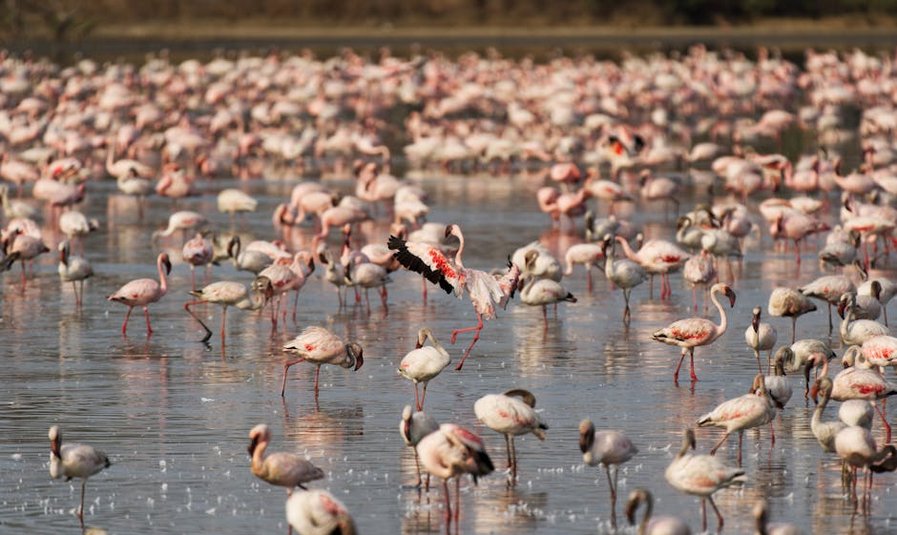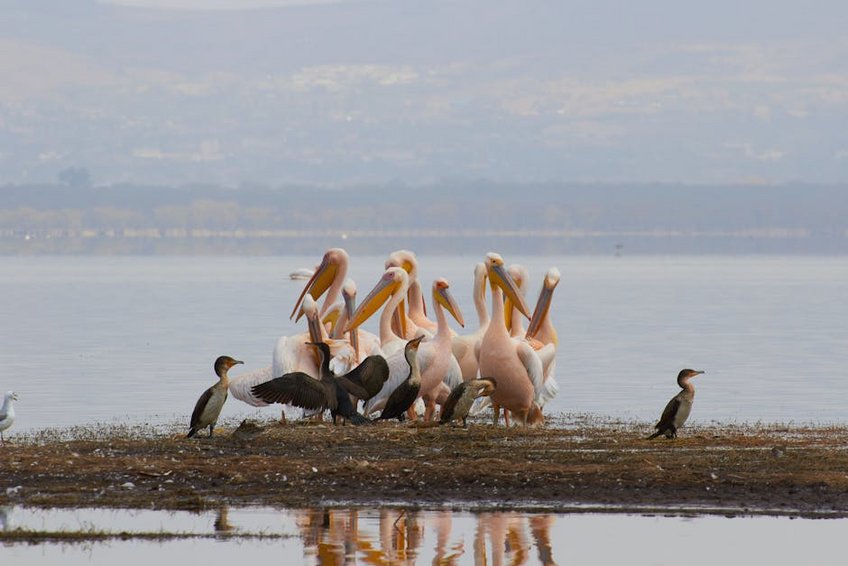Kenya Lake Nakuru Flamingo Watching: Your Ultimate Pink Paradise Guide
Imagine standing on the shores of a shimmering alkaline lake, where thousands of flamingos create a living pink carpet against the African sky. Kenya Lake Nakuru flamingo watching offers one of the planet’s most spectacular wildlife spectacles, drawing nature enthusiasts and photographers from across the globe. Located in the Great Rift Valley, Lake Nakuru National Park protects this unique ecosystem where both lesser and greater flamingos gather in massive numbers, feeding on the abundant algae that gives them their vibrant coloration. You’ll discover not just breathtaking birdlife but also rhinos, lions, and diverse landscapes during your safari adventure. This comprehensive guide covers everything from optimal visiting seasons to budget-friendly options, ensuring your Kenyan flamingo experience becomes an unforgettable journey. Prepare to immerse yourself in a world where nature’s artistry unfolds daily, creating moments that will linger in your memory long after you return home.
Kenya Lake Nakuru Flamingo Watching – Essential Information
Understanding Lake Nakuru’s unique characteristics enhances your appreciation for this remarkable destination. The lake’s high alkalinity creates perfect conditions for blue-green algae growth, which serves as the primary food source for flamingos. These elegant birds filter-feed using their specialized beaks, consuming up to 200 grams of algae daily to maintain their pink pigmentation. Lake Nakuru National Park spans approximately 188 square kilometers and was established in 1961, later receiving Ramsar Convention designation for its wetland importance. Beyond flamingos, you’ll encounter over 400 bird species and numerous mammals including endangered Rothschild’s giraffes and both black and white rhinos. The park’s conservation success stories make it a model for wildlife protection in East Africa, offering you a chance to witness conservation in action while enjoying spectacular scenery.
What Makes Lake Nakuru Special for Flamingo Watching?
- Lake Nakuru hosts between one and two million flamingos during peak seasons, creating the world’s greatest bird spectacle visible from designated viewpoints and walking trails.
- The lake’s chemical composition supports massive algal blooms that attract flamingos year-round, though numbers fluctuate based on water levels and food availability.
- National Park protection ensures minimal human disturbance, allowing you to observe natural flamingo behaviors like courtship displays and communal nesting from respectful distances.
- Budget options including camping outside the park and self-drive arrangements cost approximately $50-100 USD daily covering basic park fees and supplies.
- Mid-range safaris with lodge accommodation and shared game drives typically range from $150-300 USD per person daily including meals and guided activities.
- Luxury experiences featuring premium lodges and private guides can exceed $400 USD daily with enhanced amenities and exclusive viewing opportunities.
- Kenya Wildlife Service – Lake Nakuru National Park
- Lonely Planet – Lake Nakuru Travel Guide
The History and Ecology of Lake Nakuru
Lake Nakuru’s transformation into a protected area began when conservationists recognized its critical importance for flamingo populations. The lake sometimes experiences dramatic water level changes that affect flamingo numbers, with birds migrating to nearby lakes like Bogoria when conditions shift. Park management maintains carefully balanced ecosystems through controlled burning and invasive species management. You’ll learn about successful rhinoceros conservation programs that have brought these magnificent creatures back from near extinction. The park’s varied habitats include yellow acacia woodlands, rocky cliffs, and grassy plains supporting diverse wildlife beyond the famous flamingos. Understanding these ecological dynamics helps you appreciate the delicate balance sustaining this unique environment.
Kenya Lake Nakuru Flamingo Watching – Planning Your Trip
Strategic planning ensures you maximize your Lake Nakuru experience while managing expectations about flamingo populations that naturally fluctuate. Begin by determining your travel dates based on bird concentrations and weather patterns, then establish a realistic budget covering park fees, accommodation, and transportation. International visitors should verify Kenya’s visa requirements, which typically include obtaining an e-visa before arrival for most Western passport holders. Consider combining Lake Nakuru with other Kenyan destinations like Maasai Mara or Amboseli for a comprehensive safari experience. Pack binoculars, cameras with zoom lenses, neutral-colored clothing, and sun protection for optimal wildlife viewing. Booking through reputable tour operators guarantees better access to prime viewing areas and expert guidance on animal behavior and photography opportunities.
Best Time to Visit Lake Nakuru for Flamingo Watching
Flamingo numbers peak during Kenya’s dry seasons from June to October and January to February when water levels concentrate algae and birds gather in spectacular numbers. These periods offer excellent visibility and photography conditions with minimal rainfall disrupting your game drives. November through December brings short rains that can disperse flamingos but create lush landscapes and excellent birding opportunities for other species. March to May represents the long rainy season with potentially challenging road conditions but fewer tourists and dramatic cloud formations. Early morning and late afternoon provide the best lighting for photography and highest bird activity levels. Consider visiting during weekdays to avoid domestic tourist crowds that swell on weekends and Kenyan holidays.
Budget Planning and Costs for Your Safari
Essential Preparation Checklist
Begin preparations by ensuring your passport remains valid for at least six months beyond your travel dates and obtaining necessary vaccinations including yellow fever certification. Purchase comprehensive travel insurance covering medical evacuation since quality healthcare facilities require transportation to Nairobi. Pack lightweight, breathable clothing in neutral colors alongside sturdy walking shoes, wide-brimmed hats, and high-SPF sunscreen. Bring quality binoculars and cameras with telephoto lenses for optimal flamingo observation and photography. Download offline maps and wildlife guide apps since cellular service proves unreliable within the park boundaries. Inform your bank about international travel to prevent card blocks and carry some US dollars or Kenyan shillings for incidental expenses.

Kenya Lake Nakuru Flamingo Watching – Top Attractions and Activities
Beyond the spectacular flamingo gatherings, Lake Nakuru National Park offers diverse attractions ensuring memorable experiences throughout your visit. The park’s varied ecosystems support incredible biodiversity including waterbucks, buffaloes, and elusive leopards that occasionally appear during early morning game drives. Baboon Cliff provides panoramic views across the lake where you can photograph flamingo flocks against dramatic landscapes during golden hour light. Makalia Falls offers refreshing scenery and picnic opportunities amid the park’s western section. Guided nature walks along designated trails let you discover smaller creatures and plant species often missed during vehicle-based safaris. Night game drives reveal nocturnal animals like hyenas and genets, while cultural visits to nearby communities provide insights into local traditions and conservation partnerships.
Must-See Highlights in Lake Nakuru National Park
Begin your exploration at the southern lake shores where flamingos typically concentrate in largest numbers, especially around the freshwater inlets that attract diverse birdlife. The rhino sanctuary represents another essential stop, offering exceptional viewing opportunities for both black and white rhinos within protected enclosures. Lion Hill Lodge area frequently hosts prides resting in acacia trees, creating iconic African safari moments perfect for photography. The alkaline lakeshores themselves provide fascinating geological features and unique photographic opportunities, especially during sunrise and sunset when light transforms the landscape. Don’t miss the euphorbia forests on the eastern slopes where you might spot leopards and numerous bird species inhabiting these distinctive candelabra trees.
Hidden Gems and Local Favorites
Venture beyond the main tourist circuits to discover Lake Nakuru’s lesser-known treasures that provide more intimate wildlife encounters. The northern marshlands host specialized bird species like the African fish eagle and various kingfishers that often go unnoticed by hurried visitors. Local guides can direct you to seasonal wildflower displays that carpet certain park areas following rains, creating spectacular color contrasts against the lake’s blue waters. The park’s western boundary offers quieter game viewing routes where you might encounter smaller mammal species and enjoy peaceful moments away from vehicle congestion. Early morning visits to the eastern shoreline often reveal wildlife activity missed by afternoon tourists, including predator movements and unique bird behaviors.
Kenya Lake Nakuru Flamingo Watching – Practical Travel Information
Navigating Lake Nakuru National Park requires understanding access points, transportation options, and accommodation choices to optimize your visit. The park maintains three main gates—Main Gate, Lanet Gate, and Nderit Gate—with varying proximity to different attractions and accommodation facilities. Most international visitors fly into Jomo Kenyatta International Airport in Nairobi, then drive approximately 2.5 hours to reach the park, though domestic flights to Nakuru airstrip provide faster alternatives. Within the park, 4×4 vehicles prove essential for navigating sometimes challenging roads, especially during rainy seasons. Accommodation ranges from basic campsites to luxury lodges, with mid-range options offering the best value for most travelers. Park fees contribute directly to conservation efforts, with current rates approximately $60 USD daily for non-resident adults and $35 USD for children.
| Accommodation Type | Features and Amenities | Price Range (USD) |
|---|---|---|
| Budget Camping | Basic facilities, self-catering, shared bathrooms | $10-30 per night |
| Mid-Range Lodges | En-suite rooms, restaurant, swimming pool, game drive packages | $100-250 per night |
| Luxury Properties | Private guides, spa services, gourmet dining, exclusive viewing areas | $300-600 per night |


